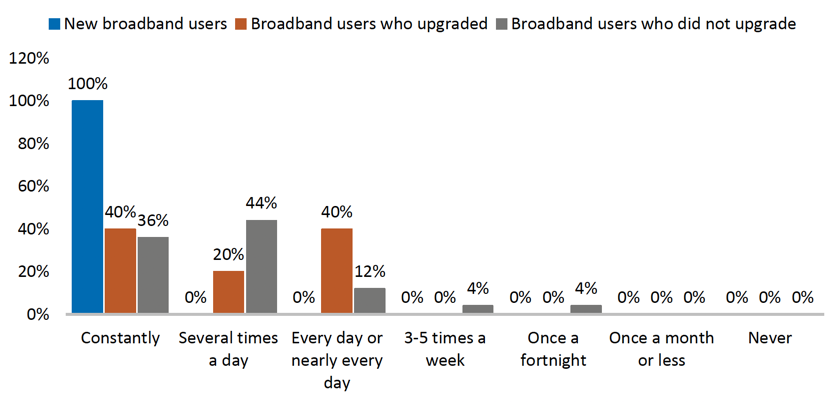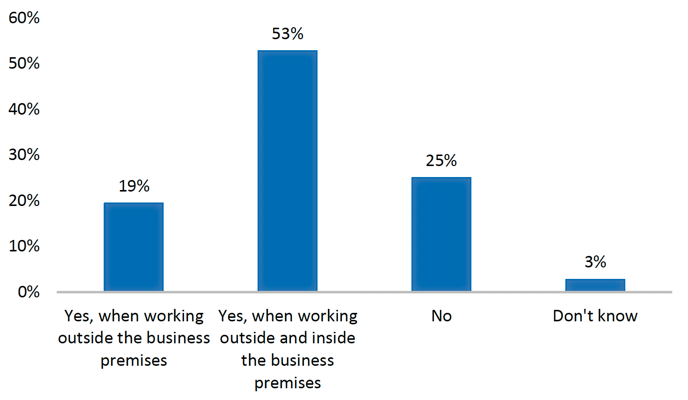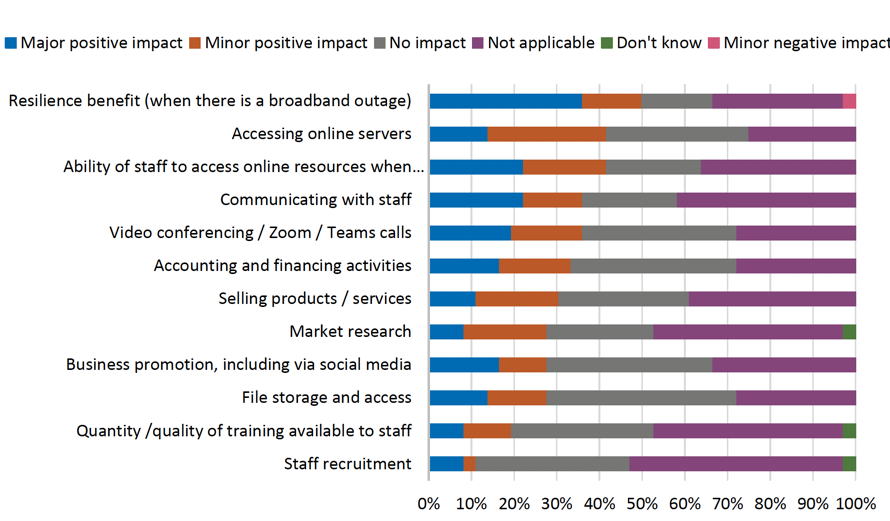Scottish 4G Infill Programme Evaluation
This report details findings of the Scottish 4G Infill Programme (S4GI) Evaluation, informed by the best practice set out in the Digital Appraisal Manual for Scotland (DAMS): https://www.gov.scot/publications/digital-appraisal-manual-for-scotland-guidance/
7 Stage 1: Survey ‘before and after combined’ Results – Businesses
7.1 Overview
7.1.1 As set out in Chapter 5, ‘before AND after combined’ surveys aimed at businesses were issued by post to properties in the locations where masts had been installed. As with the resident surveys, the business surveys were designed to gather information on the outcomes and impacts of S4GI and the extent to which the project is achieving its Investment Objectives and included questions covering the following broad topic areas:
- Broadband:
- Business broadband connectivity prior to and any changes since the delivery of S4GI
- Satisfaction with broadband
- Frequency and use of broadband
- Impact on business activities and business performance (those signing up to new/ upgrading business broadband)
- Mobile connectivity:
- Level of mobile phone connectivity and reliability prior to and since the delivery of S4GI – inside (only where respondents does not have broadband) and outside business premises
- Impact of S4GI on frequency of use of mobile services and impact on business activities / business performance
- Behavioural impacts of S4GI on:
- decision to operate in the area
- impact of 4G on employees working from home
- impact of 4G on source of supplies / raw materials
7.1.2 As set out in Chapter 5, 36 survey responses were received to the business surveys. This chapter provides a summary of these responses, working through the above topic areas, one-by-one. As with the resident surveys, direct quotes from the open text responses within the business surveys are referred to in the below narrative where relevant.
7.2 Broadband
Business broadband connectivity
Pre-existing broadband connections
7.2.1 In total, 83% (n=30) of the businesses who responded to the survey had a pre-existing broadband connection prior to the delivery of S4GI and 17% (n=6) did not.
7.2.2 Amongst the businesses with a pre-existing broadband connection, 39% (n=14) said they had a decent broadband connection (defined as defined as 10 Mbit/s download and 1 Mbit/s upload speed) and 44% (n=16) said their connection was less than decent. In terms of connection, 57% (n=17) had a cable connection, 40% (n=12) used another means, and one business did not know.
Key Point: the majority of businesses surveyed had a pre-existing broadband connection.
Changes made to broadband connection
7.2.3 Of the businesses with a pre-existing broadband connection, 17% (n=5) stated that they had upgraded their connection because of S4GI compared to 83% (n=25) who had not.
7.2.4 Of those who stated that they did not previously have a broadband connection (n=6), two said they had signed up to a broadband contract because of S4GI.
7.2.5 Of the seven businesses that either upgraded their broadband or signed up, six chose a connection that utilised 4G connectivity.
Key Point: around 1/5 of the businesses surveyed had made a change to their broadband connection (either upgrading or purchasing a new contract having not previously had one) because of S4GI.
Satisfaction with broadband connectivity
New business users who had signed up to broadband having not previously had a connection and businesses who had upgraded their broadband connection
7.2.6 Two businesses had signed up to broadband because of S4GI having previously not had a connection and five businesses had upgraded their broadband connection because of S4GI. The data suggests that those who signed up were satisfied with their broadband speed and reliability, and those who upgraded were more satisfied with the speed and reliability and their upgraded broadband connection than they were with their previous connection. However, the sample sizes are small and therefore it is difficult to draw any firm conclusions.
Key Point: New and upgraded business broadband users are highly satisfied with their service.
Use of broadband services
7.2.7 Figure 7‑1 shows how frequently businesses with broadband use their broadband connection. The results are split between businesses newly signed up to broadband; businesses who upgraded their broadband connection; and businesses who did not upgrade their connection. As shown, the vast majority of businesses across all categories used their broadband almost every day.

7.2.8 Businesses who upgraded their existing service were also asked about the frequency of use prior to the delivery of S4GI. The same size in this case is small (n=5) and therefore it is difficult to draw any firm conclusions, but the data does suggest that those who upgraded use their broadband more frequently than they did previously. Additionally, both businesses that signed up to broadband because of S4GI having previously not had a connection said they utilise their broadband connection on a constant basis.
Key Point: new business broadband users are the heaviest broadband users in the sample.
Impact of broadband availability on business activities and performance
7.2.9 The businesses who signed up to or upgraded their broadband because of S4GI were asked about the impact of this on both business activities and business performance.
7.2.10 While the sample size is small and therefore it is difficult to draw firm conclusions, the responses suggest that for business who signed up or upgraded their broadband connection there has been a positive impact on the majority of business activities. Particular benefits were identified with respect to the following activities:
- ‘accounting and financing’ and ‘accessing online servers’ – all seven businesses recorded a positive impact
- ‘file storage and access’, ‘video conferencing, zoom, and team calls’, and ‘market research’ – six out of the seven businesses recorded a positive impact
- ‘selling products and services’ and ‘business promotion, including via social media’ – five out of the seven businesses recoded a positive impact
7.2.11 While some businesses identified positive benefits for ‘staff recruitment’ and the ‘quality / quantity of training available for staff’, most businesses selected not applicable for these aspects.
7.2.12 In terms of business performance, the majority of businesses identified positive benefits with respect to the following aspects:
- ‘product / services provided’ – five recorded positive impacts
- ‘employee productivity / efficiency of working patterns – four recorded positive impacts
7.2.13 However, on other aspects of business performance, the results were more mixed. For example:
- ‘turnover’ – one business recorded a positive impact compared to two who said it had a negative impact and three said not applicable
- ‘overhead costs’ – three business recorded a positive impact compared to two who said it had a negative impact.
- ‘cost of supplies and raw materials’ and ‘recruiting new staff’ – two business recorded a positive impact compared to one who said it had a negative impact.
Key Point: The data suggests that signing up to or upgrading their broadband resulted in positive benefits for business activities and to a lesser extent business performance. It may be the case that some aspects of the latter take longer to materialise.
7.3 Mobile Connectivity
Mobile phone connectivity and reliability
7.3.1 The business were asked about mobile phone connectivity and reliability prior to and post the delivery of S4GI. A different set of questions was used depending on whether the businesses had a broadband connection as follows:
- Those who did not have broadband – were asked questions about the level of mobile phone connectivity and reliability inside their business premises and outside their businesses premises in the local area as they are reliant on their mobile phone for internet access in both locations.
- Those who had broadband – were asked questions about the level of mobile phone connectivity and reliability outside their business premises in the local area only as it was presumed that they would use their broadband connection rather than their mobile connection when they were inside their home.
Connectivity and reliability inside the business premises (where business does not have broadband)
7.3.2 As discussed above, four businesses indicated that they did not have access to broadband prior to S4GI and had not upgraded as a result of the programme. Three of the four businesses indicated that there was an improvement in mobile phone signal and reliability inside their business premisses. However, the numbers are small and therefore it’s difficult to draw any firm conclusions form this data.
Key Point: most of those still without broadband at their business do report improved connectivity and reliability inside their businesses as a result of S4GI, however, sample sizes are small and therefore it’s difficult to draw firm conclusions.
Connectivity and reliability outside the business (for businesses with and without broadband)
All[61] the businesses were asked whether there had been a general improvement in mobile connectivity outside of their business premises in their local area since the delivery of 4G services.
7.3.3 Figure 7‑2, 83% (n=29) were aware of the improvements compared to 17% (n= 6) who were unaware. However, 20% were with a mobile phone operator which enabled them to access the improvements.

7.3.4 Those respondents who indicated that they were aware of a general improvement in mobile connectivity outside of their business premises in their local area since the delivery of 4G services were also asked to indicate on a scale of 0 to 10, how reliable the mobile phone signal outside of their business premises was both before and after the delivery of S4GI. The results of this question are shown in Figure 7‑3.

7.3.5 The data suggests that mobile phone signal reliability has improved since the S4GI Programme was implemented. While previously, the majority of respondents indicated they were dissatisfied with reliability, most are now satisfied, with an average score of 1.9 prior to the delivery of S4GI and an average score of 8 post the delivery of the programme.
7.3.6 While improved service was identified in the survey responses, as with the resident survey, a number of businesses made comments in the open text responses about the need to be with a specific provider to access services:
- “Mobile signal at the business is only available to EE customers. I am with a different provider and was not made aware of the improvement in service. until I saw people outside talking on their phones when before it was impossible.”
- “Would be nice to have more providers available on the mast.”
Key Points: the sample reports significant improvements in level of connectivity and satisfaction with the reliability of the mobile phone signal outside people’s businesses. However, the dependence on a single provider was cited as a problem by some.
Use of mobile services
7.3.7 All businesses were asked whether the availability of 4G mobile connectivity had increased the use of mobile services. The results are shown in the figure below.

7.3.8 Over 70% of businesses said their use of mobile services had increased, with the majority of these indicating that their use increased both inside and outside of their business premises.
Key Points: around three quarters of business respondents noted an increase in their use of mobile 4G services as a result of S4GI.
Impact of 4G availability on business activities and performance
7.3.9 Figure 7‑5 shows the impact of 4G availability on a range of business activities as identified by the businesses who responded to the survey.

7.3.10 The data suggests that 4G mobile connectivity has had a positive impact on a range of business activities. Particular benefits were identified with respect to the following activities:
- ‘resilience (when there is a broadband outage)’ – 50% (n=18) identified this as a positive benefit. This corroborates some of the findings identified in the literature review which identified the ability of 4G to act as a back-up when broadband is unavailable as a key benefit, particularly given the decline of cash payments (see Section 3.7.2). One business identified 4G as having a negative impact on resilience. This business stated that they lost mobile coverage when the electricity went out.
- ‘accessing online servers’ – 42% (n=15) identified 4G mobile technology as being beneficial for this aspect.
- ‘ability of staff to access online resources when outside of business premises’ – 42% (n=15) identified this as a positive benefit. Given the profile of businesses surveyed, with a high proportion of both sole traders and businesses who employ staff who work in the local community during the course of their job (44% and 38% respectively), it may be that this is more about the latter than staff being able to work from home during the course of their employment. This is corroborated by responses to the question on whether there had been an increase in home working since the delivery of 4G. In total, only four out of a possible 19 businesses[62] responded to this question, with just one business stating that there had been an increase in home working; two stating there had been no change, and one stating that that the nature of the job meant that working from home was not possible.
- ‘communicating with staff’ and ‘video conferencing / Zoom / Teams calls’ - 36% (n=13) identified 4G mobile technology as being beneficial for these aspects.
7.3.11 Some businesses also identified positive benefits for ‘staff recruitment’ and the ‘quality / quantity of training available for staff’, and as with the benefits of broadband on these aspects, it may be the case that these take longer to materialise, so these figures may increase over time.
Key Point: the S4GI has brought a range of positive impacts in terms of how businesses undertake their activities, including resilience benefits, access to online servers and resources, and improved communication with staff.
7.3.12 Figure 7‑6 shows the impact of 4G availability on a range of aspects of business performance as identified by the businesses who responded to the survey.

7.3.13 Across most of the aspects of business performance, a proportion of businesses identified the availability of 4G as having a positive impact on them. The aspects for which the highest proportion of businesses recorded positive impacts were ‘customer base’ and ‘employee productivity / efficiency of working patterns’, with 33% and 28% of businesses respectively stating 4G had had a positive impact on these aspects. Some negative impacts were also identified, particularly with respect to ‘overhead costs’.
7.3.14 A range of benefits of 4G were also identified in the open text responses to the survey. These included employee productivity / efficiency gains due to enhanced communication and improved levels of safety:
- “It has made communication more flexible. It has made my business more efficient and safer as I can now communicate while working away from the farmhouse.”
- “Farming business, does make it easier to communicate and is a benefit for safety reasons.”
7.3.15 One respondent also noted the resilience benefit, echoing comments made in the resident survey:
- “It gives me confidence that I am not wholly reliant on the broadband I have which is subject to stormy weather”
7.3.16 Access to a wider customer base was also highlighted, specifically in relation to tourism accommodation:
- “I run a tourism accommodation business at Blairmore - residents were tolerant of poor mobile telephone service before the 4G mast arrival - but it’s a benefit now to have good 4G reception and good mobile telephone communication.”
7.3.17 Businesses were also asked whether there had been a change in where they get supplies / raw materials since the delivery of 4G. The majority (56%, n=19) reported no significant change, while a third (32%, n=11) said this was not applicable to them. Three businesses said there was a change with one indicating they now used more local suppliers. The remaining two said they now used suppliers based further afield.
Key Point: as noted above, S4GI has brought a range of positive impacts in terms of how businesses undertake their activities, with communication and resilience benefits noted, and for a significant number of businesses, this has led to improvements in business performance across a range of criteria, including improved employee productivity and access to a wider customer base.
7.4 Decision to operate in the area
7.4.1 The businesses responding to the survey were asked how long they had been operating at their current location. In total, 86% (n=31) has been operating at their current location for more than two years and 14% (n=5) had been at their current address for less than two years.
7.4.2 Those who had moved to their current location within the last two years were asked whether the availability of 4G mobile technology had been a factor in their decision to begin operating in the area. Of the five businesses in this situation, one identified the availability of 4G as one of a number of important factors, two considered it a minor factor, and two stated that the availability of 4G was not a factor in their decision to operate at their current location. Given the sample size in this case, it is difficult to draw any conclusions from this data.
Key Point: there is some evidence that the S4GI Programme has removed a potential barrier to businesses setting up and operating in the affected areas although sample sizes are small.
Contact
Email: sean.murchie@gov.scot
There is a problem
Thanks for your feedback